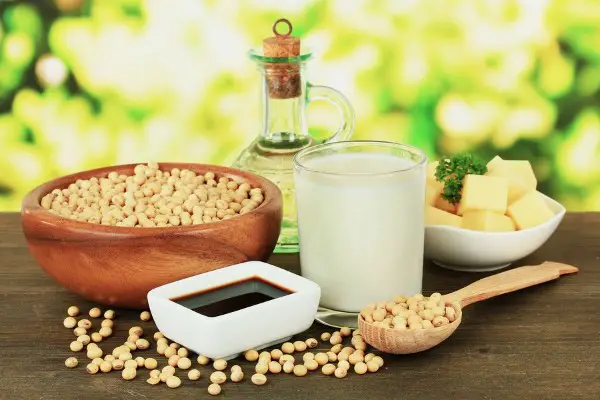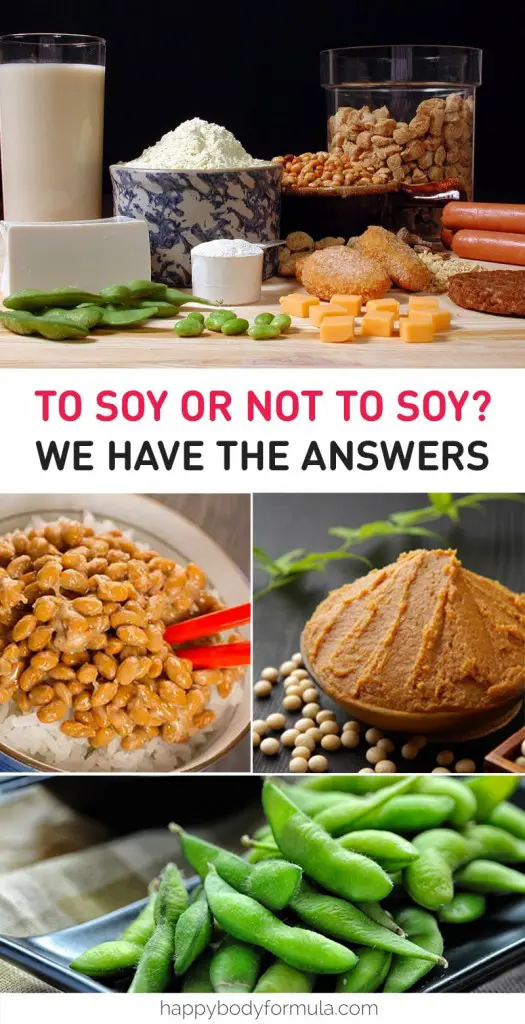Ah, soy. It’s a controversial topic in the paleo and real food communities. A strict paleo diet says no soy whatsoever, but for many, it’s a grey area.
A lot of individuals may feel it’s a bit too strict, and while we understand why soy is being left out – a topic we’ll cover here – we have to look at the bigger picture.
For example, soy is one of the re-introductions we do in the 9-week Happy Body Formula program, but we limit that to gluten-free soy sauce and fermented foods like miso, rather than recommending swapping beef for tofu (which we definitely don’t do).


See – marketing makes soy sound a lot like a health food. It’s sold in green packaging promoting healthy plant proteins, but there’s so much missing on those labels.
Even worse are the less obvious foods that contain soy. If you peruse the labels in the aisles at the store long enough, you’ll find soy in everything. From damaging, refined soybean oil to soy protein, it’s used to bulk up packaged foods while keeping them cheap.
It goes without saying, there are no redeeming qualities in these additives!
The problem with soy


First, let’s get into the issues with soy. There are some redeeming factors which we’ll cover later, but we have to make it clear why soy has become so “evil” in the real food world.
We don’t like to toss labels on things that simply say “good” or “bad,” so it’s worth it to just fall back on what is always true – science! We know a few things about soy that aren’t doing our health any favors.
- Phytoestrogen. This is a compound found in soy that mimics estrogen in the body. Seems like a problem – right? Not only does it raise estrogen levels, but this will generally lead to a drop in testosterone. This can throw healthy hormones out of whack pretty easily for both men and women. This is mostly an issue when you’re consuming soy often and in larger doses, like with soy milk and tofu. Phytoestrogen can be broken down some during the fermentation process, soy fermented soy foods are less likely to impact hormone levels significantly. Men are at risk of low libido, and women can experience disruption in a healthy menstrual cycle. These are the most obvious signs to watch out for.
- Genetically modified crops. Even if the Japenese have thrived on soy products for centuries (a note on this later), we have to understand that the crops we derive most of our soy foods and soy additives from are GMO crops. This means the nutritional value is highly compromised, and the nutrient-density is far less than organic, non-GMO soy crops would yield.
- Phytates. Like grains and legumes, we have to be aware of the phytic acid content. We know that soaking, sprouting, fermenting, and other prep measures can significantly reduce phytates, which is why we know fermented soy is better. Phytates are mainly an issue because they love to bind to certain minerals, making them less easily absorbed by the body. These include but are not limited to zinc, calcium, iron, and magnesium.
- Lectins. Lectins are another anti-nutrient like phytic acid that bind to molecules and interfere with nutrient absorption in similar ways. Moreover, lectins can lead to leptin sensitivity which can throw your hunger and energy levels off balance, and over time, lead to insulin resistance or metabolic syndrome.
Different types of soy foods


Edamame. These are soybeans, picked and sold before they’re mature. You can often find them fresh or in the freezer section, in bags ready to steam and boasting plant protein!
While they might look quite like peas in the pod, they come with a lot of the similar dangers of soy. They are less harmful than mature soybeans as their fatty acid profile is mostly monounsaturated and they contain less anti-nutrients while young.
Don’t panic if you eat a handful at a sushi restaurant, but don’t make them a staple either.
Soy sauce & Tamari. Soy sauce is a fermented soy product, as well as Tamari. Traditional soy sauce generally includes wheat as well. While it’s often used in small amounts, we have to watch out!
Tamari is a wheat-free version, so we can get on board with its fermented food benefits in moderation. It’s great to drizzle over stir-fries, add to marinades, or dip sushi/sashimi in.
Tofu. Tofu is arguably the most popular plant-based protein. It’s known both for its bland taste and its subsequent ability to take on flavors from marinades, rubs, sauces, and more.
Basically, it’s soybean “curd,” and it’s often sold in blocks with different firmness levels and moisture levels, making it easy to use for different cuisines – crumbled like eggs in a scramble, or grilled in blocks like steak.
Natto. Natto isn’t for everyone. It smells a little funky, and it has a rather stringy texture. If you can get down with it, though, it’s hands down one of the healthiest soy products.
It’s simply a soaked, boiled, and fermented soy bean. It has a unique benefit of vitamin K2 due to the bacteria strain it’s fermented with, amongst some other positive nutritional gains.
Miso. Miso is a fermented soybean paste that is often used to add “umami” to dishes and deepen the flavor. It’s salty, and it comes in a few varieties. Considering its strong flavor, you truly don’t need to use much.
Considering its good bacteria content, using a bit of miso can actually be a super healthy addition to the diet from a non-GMO source. Read more about why Irena includes it in her modified paleo diet, and how she uses it including as a glaze or as a flavor injection to a healthy bone broth.
Soy milk. A popular plant-based milk made from soy beans. Since nut milks have become more common (i.e. almond milk, coconut milk, cashew milk, etc.), soy milk has taken a back burner.
Many people view this as a healthy alternative to dairy milk, but daily consumption in coffee drinks, cereals, and more can be a bit of soy overload, and we highly suggest using a different dairy alternative.
Tempeh. Finally, we have yet another fermented soy food that can be a great alternative for meat on Meatless Mondays, or stand in to save you some money in the food budget while still meeting your protein goals.
Tempeh is basically fermented soybeans that are bound together into a “loaf” or soy cake. It has a firm texture – perfect for grilling – and a nice, mellow, earthy taste. It’s admittedly a bit more palatable than tofu with loads of extra health benefits.
Soy protein isolate. When it comes to supplementing with protein, soy is a bad choice. It’s made from dehulled and defatted soybeans (which doesn’t even sound good).
It is often used as a protein supplement or found in protein bars – especially vegan ones. Its protein content is outweighed by all of the negative factors and anti-nutrients, so if you need to shake things up, check out our favorite real food protein powder choices.
The health benefits of soy


Say what? Yes – we totally believe including soy in your diet can be perfectly healthy! Of course, this is mainly up to the individual to see if they react poorly to soy, but as you can see, there are tons of soy products.
Moreover, these products are not created equal. You can probably tell we lean towards fermented soy products, and we’re going to talk a bit more about why we dig ’em so much here.
- Fermented soy breaks down high levels of phytic acid and other anti-nutrients found in traditional soy products. It’s worth noting that fermentation does not remove all isoflavones (the phytoestrogen) or goitrogens, but considering the smaller quantities we encourage using, these things are negligible. After all, many plant foods contain anti-nutrients and goitrogens (e.g. cruciferous veggies like broccoli and cauliflower) that we aren’t as worried about.
- Vitamin K2 is produced in natto and other fermented food products, although natto has the highest content of all foods. Weston A. Price called this “The X Factor vitamin” because we don’t get quite enough of it, but it has amazing benefits including its ability to increase mineral absorption and its effectiveness at preventing and repairing tooth decay – something Price studied extensively.
- When eaten alongside an iodine-rich diet, fermented soy can be a true super food. Iodine is crucial for this because we have to protect the thyroid. In hypothyroid or iodine-deficient individuals, soy can put the thyroid at risk. To prevent that, including plenty of healthy fats and iodine in the diet from foods like grass-fed butter, raw cheese, yoghurt, and sea vegetables will ensure thyroid health with or without soy.
How much soy is safe to consume?


Like with most problematic foods, without an allergy or determined sensitivity, the poison is in the dose. Eating soy in large quantities daily is obviously a big no-no if you ask us, but a little bit can be a non-issue for most.
Plus, you can now take into account the health benefits of soy, and the most nutritious variations of soy.
You also might be wondering about the Asian population and their soy consumption. It’s widely accepted knowledge that Asian cultures eat a LOT of soy and live long lives.
While we can give it to ’em when it comes to longevity, we have to clear some things up. Most Asian families probably aren’t eating tofu three times a day.
Instead, most of their soy consumption is fermented soy in small or reasonable quantities, alongside other vitamin and mineral-rich foods like fish and vegetables.
We hope you learnt more about why soy isn’t the health food the market has made it out to be, and how to better navigate including soy in YOUR diet.
Let us know you liked it by sharing this with your healthy living and clean eating friends!
Share this article on Pinterest!
Music, mountains, dogs, travel, food and friends.

